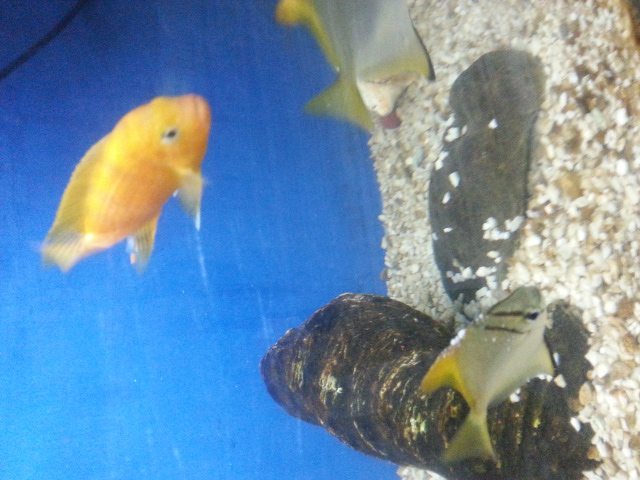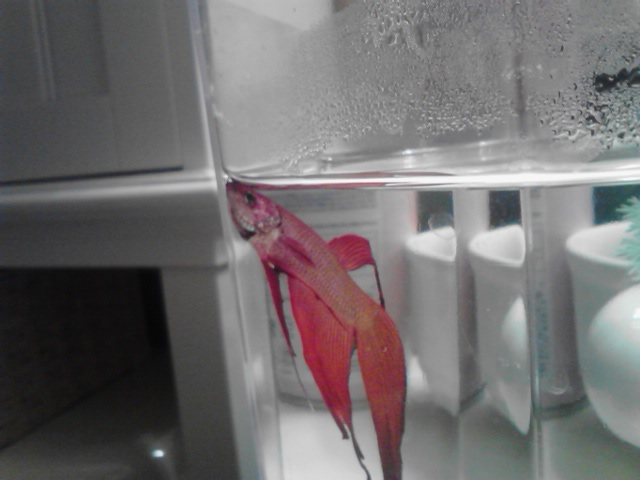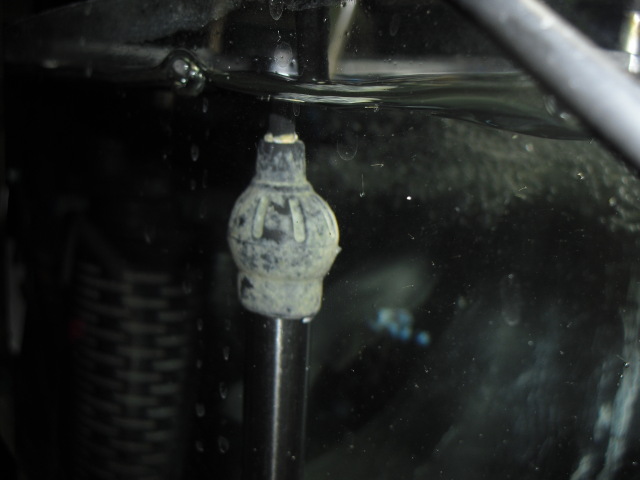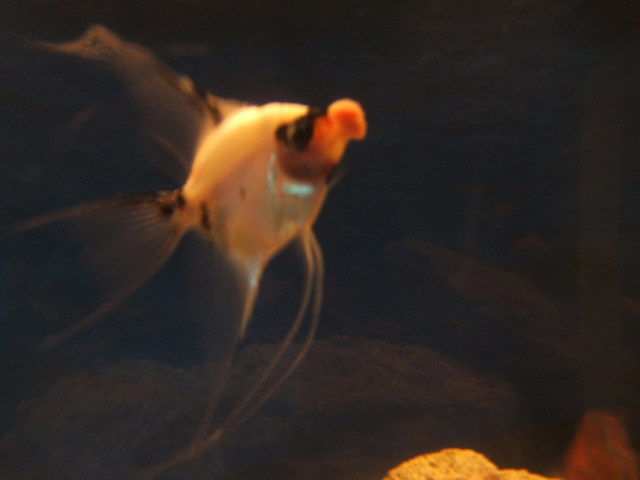QuestionDear Karen,
Greetings from Amman :)
Never had i even imagined that such a website and such a great knowing and helping people like you does exist! all the good things on the net is either flooded with Adds, or just a commercial junk..So i thank you in advance for all your efforts and responses :)
Well, i am a beginner in the world of freshwater aquariums, and have some questions, hope you find the time to answer them :)
Mmmm,,my plan is a freshwater 55 Gal ready made aquarium with all its equips and acces. i have an RO drinking water filter (heard that soft water makes it better, so i might use it for the aquarium according to your advice).
1-tank dimensions 120LX40WX60H cm got a triple stage filter (bio, chemical, physical) a 200 watts heater, and an airpump. is that enough for a startup?
2-I like Angel fish, but heard that its difficult to have them spawn in aquariums, is that true? if not, whats best thing i can do to have a success in seeing a school of young angels? in my country, its very difficult to find live food , only frozen dried flakes or pellets are available, so what can be an alternative for feeding new fries?
3-Cichlid colors amazes me, but many told me they hate angels, is that true? even if the aquarium was big enough?
4-im planning to put the follwoing fishes together in the community tank: Angels, Mollies, Gubby,Gourami (3 species) discus,silver dollar, plecos, ghost knife, glass knife, Zebra danios, and maybe cichlid.. i know its a tough combination, but what do u advise for a best compatibility? i like having a festival-like colors in my aquarium! :)
5-after filling up the aquarium, what should i do to start a fishless cycling? and if i wanted to put a couple of fishes as a "stratup" is that ok? how long does a 55 gal tank needs to be ready for hosting fishes after its up and running?
6-if i bought the fishes from one shop, is it necessary to put them in quarentine before going into tank? they wil be the 1st inhabitants!
7-Is good chemical and bio filtration enough or i need the weekly 20% water change? how can i measure ammonia, NO2 and NO3 in tank? dipsticks or i need to get an electronic sensor?
8-do you know any resources that can help me knowing more about fish species,diets,breeding and habbits? website or books are ok. but websites are preferred :)
9-do u recommend real plants or plastic? i have ZERO knowledge about plant species that is good for aquariums!
Im very thankful for your help, and your reply will be most appreciated ,,
Thanks again :)
Tareq
JORDAN
AnswerHello Tareq! Greetings from all the way from Texas!
Thank you for your extremely nice and sincere comments!
I will do my best to answer all your questions and more!
1). A 55 gallon aquarium is the perfect size to start with. Your filter, heater, and airpump should work out just great!
2.) Angelfish are great. I love them. They aren't particularly hard to spawn as long as the water conditions are good but the main problem is the other fish in the aquarium eating the eggs or fry as soon as they are laid or hatched. Otherwise, Angelfish make good parents for their brood and both mother and father fish care for the eggs and fry. But for the most succesful spawn, a pair should be in an aquarium of their own.
3.) Cichlids are a extremely diverse group of hundreds of species of every shape and color imaginable. Some fishkeepers specialize only in them for their interesting habits and behaviors along with their beautiful colors are quite amazing. But the majority of cichlids are very aggressive and territorial. They do not belong in the average community aquarium and are best kept in a large tank either to themselves or other equally sized and equally bold fish.
4.) It sounds like you have wonderful ideas for your fish combinations. However, you can be pushing the limits on your stocking capacity, but you can deal with that through very frequent water changes to control pollution levels.
*One of your main problems might be that the Discus which was on your list is probably too shy to live with all those other fish. It might work out though, but usually discus do best with calmer and smaller tankmates due to the discus's sensitive and docile personality. The rest of the fish should do OK but when mixing all fish it is always a gamble and you never know when a particular combination will or will not work out. Your angelfish might pester your guppies. An ideal fish combination would be one that includes Top dwellers (Guppies and Zebra danios, Gouramis), mid dwellers (Angelfish, Silver dollars, Mollies) and then Bottom dwellers which includes your Plecostomus idea. Plus other peaceful catfish like the adorable Corydoras catfish or Ottocinclus which are good algae control. Of course these listed fish are not limited to these species, I just tried to pry from your list as an idea. I know a great list of species that are error-proof and make good combinations whether it be community tank or a certain theme. Just let me know if you would like some of them. I will be happy to list them here.
5.) Fishless cycling is good. Because it avoids having to stress 'cycling' fish by high pollution levels associated when you first begin your setup. For your beneficial bacteria to begin growing and colonizing in your aquarium, they need a food source, ammonia from fish waste that is. Fishless cycling includes adding an ammonia source such as pure ammonia in the chemical form or adding a pinch ful or two of fish flakes where they will decompose and provide ammonia to begin the cycling process. Fishless cycling can work just as good as fish cycling. Sometimes it can be difficult to not put too much food or too little. Keeping test kits for Ammonia, nitrite, and nitrate handy is very valueble for whatever type of cycling you decide on. Cycling with fish is fine too, but you should never let your ammonia or nitrite levels to rise to dangerous levels. Water changes should always be preformed when these levels are high of at least 50%. Ammonia and nitrite (the by-product of the beneficial bacteria consuming the ammonia) levels should be tested daily during the first several days when the aquarium is first setup especially and thereafter until your ammonia and nitrite levels have begun to drop and nitrate begins to rise dramatically. Nitrate is the end product of the whole cycling process and when ammoni and nitrite levels have dropped to zero and nitrate rises high, your aquarium has cycled! You'll have to be very patient during this cycling which can take 4-6 weeks to get fully established.
~When cycling, start with only hardy fish and only a few. Never fully stock your aquarium right away. You need to do so gradually to avoid causing ammonia spikes because your aquarium is not fully established yet with the beneficial bacteria...With each new fish addition, they need time to adjust to the new fish load everytime--only add 2-3 fish at a time and only when your aquarium has officially cycled. Good hardy proven cyclers include-
Black skirt tetras*
Zebra Danios*
Platies*
Or plain non fancy guppies* The fancier varieties are more delicate.
3-4 Fish are good to start with on all 4 species. Feed the cycling fish very lightly at the most of 1 small flake each per fish once a day. As your aquarium gets established, you can of course feed more frequently and more variety. Right now you need to keep from polluting your aquarium as much as possible.
6.) No, you don't need to quarantine your first fish! Since this is your first tank, and I would like to keep things simple for you. Don't worry about a Quarantine tank until you get pretty advanced in the hobby. It's not very praticle for first timers to try to keep a quarantine the same time with their other aquarium running and all. Quarantine is to protect your first fish from catching an illness the newcomers can bring in. But it's not totally necessary-
*Before you buy any fish,
~Observe all the fish in that particular aquarium in the fish shop...
All the fish should be active and healthy, no ragged fins, odd spots or splotches or fuzzy spots. Listless fish are a cause for worry. Try to avoid a certain aquarium if the fish are hiding or up at the corner gasping. Overall the fish group should be perky and responsive to people.
*~When adding your fish, float the bag for 20 minutes in your aquarium with the hood lights off. Then either gently pour or set the bag into a 1gal pitcher or other container and every 5 minutes add about half a cup of your aquarium water into the bag. Continue until the container is nearly completely full, now you can consider your fish well-adjusted to your tanks water parameters and not just the temperature by floating them only.
7.) Filtration helps keep your aquarium cleaner in a way. But it cannot remove pollutants. Despite the best filtration, you still need to do water changes. This is because filters trap debri and remove some discolors, but they cannot take them out of the aquarium. You must do regular maintanance on a filter for it to do it's job well and you MUST preform water changes frequently. Nothing can replace a good water change. It's the best thing you can do for your fishes health and wellbeing. 20% is a good amount to start with but more is even better and twice a week 30% water changes are excellent.
*~Ammonia, nitrite, and nitrate can be measured easily with either liquid test tubes or dipstick tests. I feel the Liquid test tubes are more accurate but you can use Dipsticks as well. You won't need an electronic sensor but you'd be a really good fishkeeper if you did have one!
8.) I know the best book around for fishkeeping--
It's called "the simple guide to freshwater fishkeeping"
Some good websites are-
"Aquahobby.com"
"Aquariumfish.net"
"Myfishtank.net"
"Aqualandpetsplus.com" has other pets and information too!
But, If you can get ahold of "the simple guide to freshwater fishkeeping" this book will tell you everything you'll ever need to know and how to start out right with your first aquarium.
9.) Real plants are certainly better in my opinion. But both plastic and real can have their drawbacks. Let's start with the good points of Plastic--
1# They don't pollute the aquarium with dropped leaves
2# they have zero maintance besides wiping the algae off
3# they provide quick and thick cover when you need it most for your fish or any fry that need hiding places to feel secure
(Here are the bad points)
#They don't look as real or move like real does in the currents of the tank
# They won't grow or change---that's a nobrainer! ;-)
Live plants grow and change and sometimes bloom...
#They don't provide water cleaning benefits live has
#It can be hard to create a 'natural' look with plastic
-----------
Now here are the good points of Live plants-
#1- They remove nitrate and other pollutants and add oxygen to the aquarium water which is very beneficial for fish
2#They provide occasional food sources for many fish whom like to snack on them
3# Of course, they make the aquarium look very natural
4# It can be just as interesting to keep an aquatic garden of live plants as it is with fish. The plants grow and change and bloom and sometimes make seeds. It's very interesting to experiment with different live plant layouts and eventually create a garden design and look of your very own...
5# Hiding places
6#Live plants are natural and soft and won't tear the long fins of some fish that hard plastic can
7# Natural is beautiful!
(Bad points) /
# They can pollute the aquarium with their dropped leaves which can compost and add to the pollution level--these incidents are rare in wellcared for tanks, however...
# They can be harder to keep and provide somewhat of a hassle for first time fishkeepers who are having a hard enough time with keeping fish themselves
# A look cannot be achieved right away as with plastic...Plants need weeks to grow and fill in the aquarium and make it look nicer.
But if you stick to hardy easy to keep varieties---live plants won't be a hassle at all. Some easy to keep species as long as you have a good florescent light are--
*Ancharis
*Java Fern
*Java Moss
*Hornwort
*Red ludwigia
*Duckweed
And more! Of course before starting with plants, make sure you have the proper lighting conditions and your fish aren't vegetarians... Silver dollars will graze plants like a herd of goats...
Well I think I've covered everything! If you have anymore questions or concerns, feel free to email me! I am more than happy to help.
My very best wishes with you and your new aquarium!
Welcome to this wonderful hobby! I do hope you enjoy it!
Happy fishkeeping!
Karen~

 2 questions fr u!
Question
mono angel with some w
1)Recently I dis
2 questions fr u!
Question
mono angel with some w
1)Recently I dis
 Yellow Platy with Spots
Question
Yellow Platy with spot
Large white spot
Yellow Platy with Spots
Question
Yellow Platy with spot
Large white spot
 Betta needs help
Question
Flare the Fish Flare 2
I have a r
Betta needs help
Question
Flare the Fish Flare 2
I have a r
 white algae on heater and filter tubes
Question
White algae
There has been a white, pale-green
white algae on heater and filter tubes
Question
White algae
There has been a white, pale-green
 Sick angel fish
Question
Angel fish w/cauliflow
Is there any cure for m
Sick angel fish
Question
Angel fish w/cauliflow
Is there any cure for m